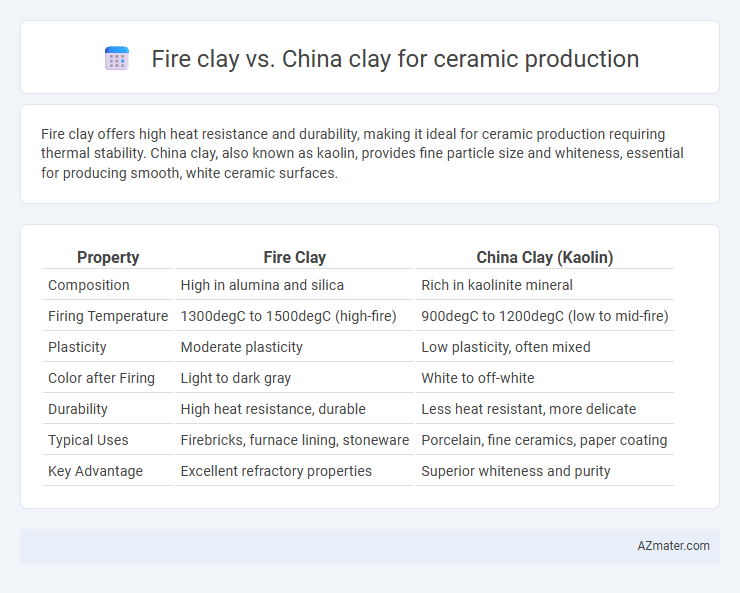Fire clay offers high heat resistance and durability, making it ideal for ceramic production requiring thermal stability. China clay, also known as kaolin, provides fine particle size and whiteness, essential for producing smooth, white ceramic surfaces.
Table of Comparison
| Property | Fire Clay | China Clay (Kaolin) |
|---|---|---|
| Composition | High in alumina and silica | Rich in kaolinite mineral |
| Firing Temperature | 1300degC to 1500degC (high-fire) | 900degC to 1200degC (low to mid-fire) |
| Plasticity | Moderate plasticity | Low plasticity, often mixed |
| Color after Firing | Light to dark gray | White to off-white |
| Durability | High heat resistance, durable | Less heat resistant, more delicate |
| Typical Uses | Firebricks, furnace lining, stoneware | Porcelain, fine ceramics, paper coating |
| Key Advantage | Excellent refractory properties | Superior whiteness and purity |
Introduction to Fire Clay and China Clay
Fire clay, a refractory clay rich in alumina and silica, is prized for its high heat resistance and durability, making it essential in ceramic production for kiln linings and fire bricks. China clay, also known as kaolin, is a fine, white clay primarily composed of kaolinite, valued for its purity, plasticity, and whiteness, which contribute to the strength and aesthetic quality of ceramics. Both clays serve distinct roles in ceramics, with fire clay enhancing thermal resistance and china clay improving workability and finish.
Chemical Composition Differences
Fire clay contains higher amounts of alumina (Al2O3) and lower silica (SiO2) content compared to china clay, resulting in superior refractoriness and thermal stability ideal for high-temperature ceramics. China clay, predominantly composed of kaolinite (Al2Si2O5(OH)4), has higher silica and lower alumina levels, making it suitable for fine white porcelain and ceramic bodies requiring plasticity and whiteness. The chemical composition differences influence fire clay's durability in kiln linings, whereas china clay enhances the whiteness and strength of ceramic wares.
Physical Properties Comparison
Fire clay exhibits higher refractory strength and thermal stability compared to China clay, making it ideal for high-temperature ceramic production. China clay, or kaolin, has finer particle size and higher whiteness, contributing to better plasticity and surface finish in ceramics. The density of fire clay typically ranges between 2.3 to 2.6 g/cm3, whereas China clay varies from 2.6 to 2.65 g/cm3, influencing the firing shrinkage and final product durability.
Plasticity and Workability
Fire clay exhibits higher plasticity compared to china clay, making it more suitable for shaping and molding in ceramic production. Its superior workability allows for easier manipulation during forming processes, reducing the risk of cracks and deformation. China clay, while less plastic, provides a finer texture that enhances the surface finish but requires careful handling to avoid brittleness in ceramics.
Firing Temperature Ranges
Fire clay typically withstands higher firing temperatures, ranging from 1200degC to 1400degC, making it ideal for stoneware and refractory ceramics. China clay, also known as kaolin, matures at lower temperatures, generally between 1100degC and 1300degC, suitable for porcelain and fine ceramics. The higher alumina content in fire clay contributes to its refractory properties and temperature resistance compared to the more plastic and white-firing china clay.
Color and Texture Outcomes
Fire clay, characterized by its high alumina content, produces ceramics with a dense, fine-grained texture and a warm, reddish-brown color after firing, ideal for refractory and pottery applications requiring strength and heat resistance. China clay, or kaolin, offers a smooth, white to off-white color with a silky texture, making it preferred for porcelain and fine china where translucency and brightness are critical. Color and texture outcomes depend on the mineral composition, with fire clay delivering earthy tones and robust textures, while china clay provides purity and subtle translucence in ceramic products.
Durability in Finished Ceramics
Fire clay exhibits superior durability in finished ceramics due to its high alumina and silica content, which enhances thermal shock resistance and mechanical strength. In contrast, china clay, primarily composed of kaolinite, offers finer particle size and whiteness but lower thermal durability and mechanical toughness. Choosing fire clay ensures greater resistance to cracking and wear in ceramic products subjected to high temperatures and mechanical stress.
Cost and Availability Factors
Fire clay, known for its high heat resistance, is generally more affordable and widely available due to abundant natural deposits, making it a preferred choice for cost-sensitive ceramic production. China clay, or kaolin, offers superior whiteness and plasticity but tends to be more expensive and less abundant, influencing its use mainly in premium ceramics and porcelain. The cost-effectiveness of fire clay combined with its local availability often outweighs the specialized qualities of china clay in large-scale manufacturing.
Best Applications for Fire Clay vs China Clay
Fire clay, rich in alumina and silica, is ideal for producing refractory ceramics such as kiln linings, fire bricks, and crucibles due to its high heat resistance and thermal stability. China clay, or kaolin, features fine particle size and high plasticity, making it best suited for porcelain, fine china, and sanitary ware where whiteness, smooth texture, and translucency are essential. Fire clay's robustness supports high-temperature industrial uses, while China clay excels in decorative ceramics and electrical insulators requiring precision and purity.
Choosing the Right Clay for Your Ceramic Project
Fire clay offers high fire resistance and thermal stability, making it ideal for ceramics requiring durability and heat endurance, such as kiln linings and refractory products. China clay, or kaolin, provides fine particle size and whiteness, lending smooth texture and strength to porcelain and fine ceramics with excellent plasticity. Selecting the right clay depends on the desired ceramic properties, with fire clay suited for high-temperature applications and china clay preferred for delicate, white-bodied wares.

Infographic: Fire clay vs China clay for Ceramic production
 azmater.com
azmater.com